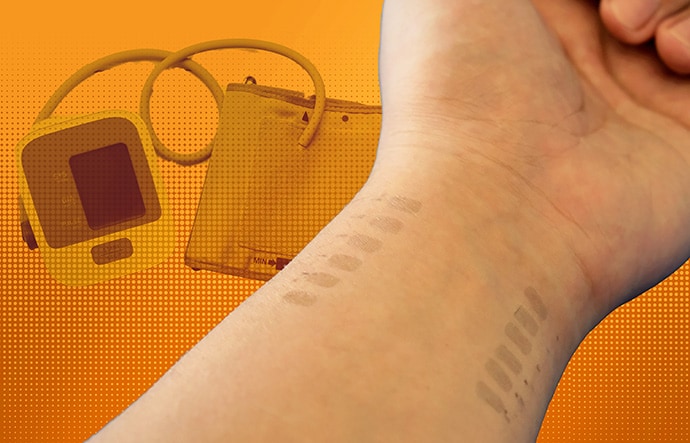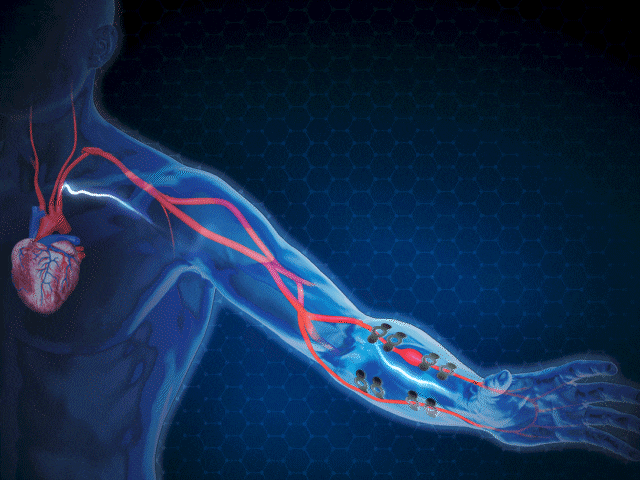As scientists work on wearable technology that promises to revolutionize health care, researchers from the University of Texas at Austin and Texas A&M University are reporting a big win in the pursuit of one highly popular target: a noninvasive solution for continuous blood pressure monitoring at home.
Not only that, but this development comes in the surprising form of a temporary tattoo. That's right: Just like the kind that children like to wear.
The thin, sticker-like wearable electronic tattoos can provide continuous, accurate blood pressure monitoring, the researchers report in their new study.

Temporary tattoos could be the future of at-home blood pressure monitoring, eliminating the need for the sphygmomanometer, or blood pressure cuff.
"With this new technology, we are going to have an opportunity to understand how our blood pressure fluctuates during the day. We will be able to quantify how stress is impacting us," says Roozbeh Jafari, PhD, a professor of biomedical engineering, electrical engineering, and computer science at Texas A&M and a co-author of the study.
Revealing the Whole Picture, Not Just Dots
At-home blood pressure monitors have been around for many years now. They work just like the blood pressure machines doctors use at their office: You place your arm inside a cuff, press a button, feel a squeeze on your arm, and get a reading.
While results from this method are accurate, they are also just a moment in time. Our blood pressure can vary greatly throughout the day — especially among people who have labile hypertension, where blood pressure changes from one extreme to the other. So, looking at point-in-time readings is a bit like focusing on a few dots inside of a pointillism painting — one might miss the bigger picture.

Once thin layers of graphene capture raw data, a machine learning algorithm interprets the information and provides results in mmHg, units used for measuring blood pressure.
Doctors may also find continuous monitoring useful for getting rid of false readings from "white coat syndrome." Basically, this means a person's blood pressure rises due to the anxiety of being in a doctor's office but is not true hypertension.
Bottom line: The ability to monitor a person's blood pressure continuously for hours or even days can provide clearer, and more accurate, insights into a person's health.
How Do Health Monitoring Tattoos Work?
Electronic tattoos for health monitoring are not completely new. John A. Rogers, PhD , of Northwestern University first put forth the idea of monitoring through temporary tattoos 12 years ago. Some concepts, such as UV monitoring tattoos, already had been adopted by scientists and put on the market. But the existing models weren't suitable for monitoring blood pressure, according to Deji Akinwande, PhD, a professor of electrical and computer engineering at the University of Texas at Austin and another co-author of the study.
"[UV monitoring tattoos] are very thick," he says. "They create too much movement when used to measure blood pressure because they slide around."
So, the Texas-based research team worked to develop an option that was slimmer and more stable.
"The key ingredient within e-tattoos is graphene," says Akinwande.
Graphene is carbon that's similar to what's inside your graphite pencil. The material is conductive, meaning it can conduct small electrical currents through the skin. For blood pressure monitoring, graphene promotes bioelectrical impedance analysis (BIA), which is like the technology used in smart scales that measure body fat.
With e-tattoos, the thin layers of graphene stick to the skin and do not slide around, getting rid of "artifacts," or bad data. The graphene e-tattoos can be worn on the skin for about a week — or roughly as long as the temporary tattoos kids love.
Once the graphene captures the raw data, a machine learning algorithm interprets the information and provides results in units used for measuring blood pressure: millimeters of mercury (mmHg), commonly referred to as blood pressure "points."
How accurate are the results? The tests measured blood pressure within 0.2 ± 5.8 mmHg (systolic), 0.2 ± 4.5 mmHg (diastolic) and 0.1 ± 5.3 mmHg (mean arterial pressure). In other words: If this were a basketball player shooting baskets, the great majority of shots taken would be swishes and occasionally a few would hit the rim. That means good accuracy.
When Will E-Tattoos Be Available?
The teams of Jafari and Akinwande are working on a second generation of their e-tattoo that they expect to be available in the next 5 years.
The upgrade they envision will be smaller and compatible with smartwatches and phones that use Bluetooth technology and near-field communication (NFC) to transfer data and give it power. With these updates, e-tattoos for continuous blood pressure monitoring will be ready for clinical trials, and mainstream use soon after.
"Everyone can benefit from knowing their blood pressure recordings," Akinwande says. "It is not just for people at risk for hypertension, but for others to proactively monitor their health, for stress and other factors."
Sources:
Roozbeh Jafari, PhD , professor of biomedical engineering, electrical engineering, and computer science, Texas A&M University.
Deji Akinwande, PhD , professor of electrical and computer engineering, University of Texas at Austin.
Nature Nanotechnology: "Continuous cuffless monitoring of arterial blood pressure via graphene bioimpedance tattoos."
Credits:
Images: The University of Texas at Austin/Texas A&M University
WebMD Health News © 2022
Cite this: The Next Blood Pressure Breakthrough: Temporary Tattoos - Medscape - Jul 25, 2022.













Comments